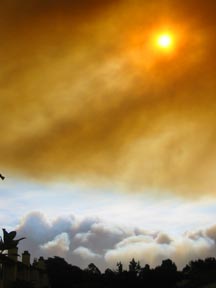TSRI Copes with Fallout from Fires
By Mika Ono
No one could have predicted the turn of events this week.
News of raging fires, anxiety about homes and loved ones,
and dark, acrid air permeated The Scripps Research Institute
(TSRI) campus, like much of the larger San Diego region.
"The fires have had an emotional impact on many of us here,"
says Keith McKeown, vice president of communications and public
relations for TSRI. "Those with homes threatened by the fires
have had immediate, pressing concerns. Others have been worried
about family, friends, and co-workers. Thankfully, the physical
facilities at the institute remain intact and we are back
to science as usual."
The predominant impact of the fires on the TSRI campus has
been poor air quality. "There were high levels of particulate
matter all around the region," says Ben Morris, vice president
of facilities services. "Except for some specialized scientific
facilities, most buildings simply aren't designed to cope
with these kinds of conditions."
The institute remained open throughout the week, with the
flexibility for employees to stay home or leave early if needed.
There was no damage to facilities or major health problems
for staff.
Judith Muñoz, vice president of Human Resources,
notes that because of the unprecedented situation and constantly
changing conditions, it was a challenge to meet both the essential
needs of employees and the essential needs of the institute.
"Determining the appropriate practices during an emergency
is never easy," Muñoz says. "We greatly appreciate
those who were able to come to work and recognize that others
had health or personal concerns that kept them from coming
to work. Our first concern during the emergency situation
has been the health and safety of our employees and their
families."
Employees who reported for work performed their jobs, adapting
to the unusual environmental conditions as needed. Some support
departments limited outside work and heavy lifting as much
as possible. Employees driving vehicles often turned their
headlights on—even in the middle of the day—to increase
visibility.
Other departments, such as Environmental Health & Safety,
were flooded with calls for more information. "Part of our
job is to respond to emergencies such as this," says Carolyn
Keierleber, director of Environmental Health & Safety, whose
department received upwards of 50 extra calls at the beginning
of the week. "We walked around, let people know that they
could go home if they were feeling ill, and provided information
on air safety."
Keierleber notes that misconceptions about face masks were
common. "Ordinary face masks can be useful outside to filter
out ash," she says. "However, since these masks don't trap
microscopic particles, wearing them indoors really doesn't
increase safety."
In the wake of the fires, TSRI instituted an emergency notification
system on the work status at the institute, in which employees
can call (858) 784-7000 to hear a recorded message. Even though
the system was set up in response to the events of this week,
the number will be available in any future regional emergency.
Jan Hill, director of the Counseling and Postdoctoral Services
Department, expects that the emotional toll of the disaster
on employees will continue. "It often takes a couple of days
for a catastrophe like this to sink in," she says, emphasizing
that her department continues to offer free, confidential
counseling for employees and their families.
Some employees have asked if TSRI will collect donations
for co-workers who have been affected by the fires. Those
who wish to volunteer or make donations to fire victims and
their families are directed to nonprofit agencies serving
the San Diego region, including:
- American Red Cross: Online donations can be made at www.redcross.org
or call 1-800-HELPNOW.
- Volunteer San Diego: Disaster recovery volunteers can
sign up at www.volunteersandiego.org .
- St. Vincent de Paul Village: Mail donations to Attn: Fire
Relief Fund, 3350 "E" Street, San Diego, Ca 92102.
- The San Diego Foundation: "After-the-Fire Fund" online
donations can be made at www.sdfoundation.org.
- Meals on Wheels for Greater San Diego: This organization
is helping homebound seniors affected by fire. To make donations
or to volunteer, call 1-800-573-6467.
- San Diego Humane Society: The society is providing services
for evacuated animals. Call (619) 299-7012.
- San Diego Animal Services: Call (858) 755-1161, x2026
to make donations for evacuated animals.
Additional disaster relief information and related resources
can be found at the Counseling
and Postdoctoral Services Department web site.

|

The fires burning in the San Diego region
made for a historic skyline. Photo by Kevin
Fung.
|

